
Ornamental, Edible Gardens at Lynmar Estate Winery
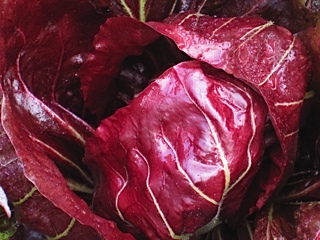
Contributor
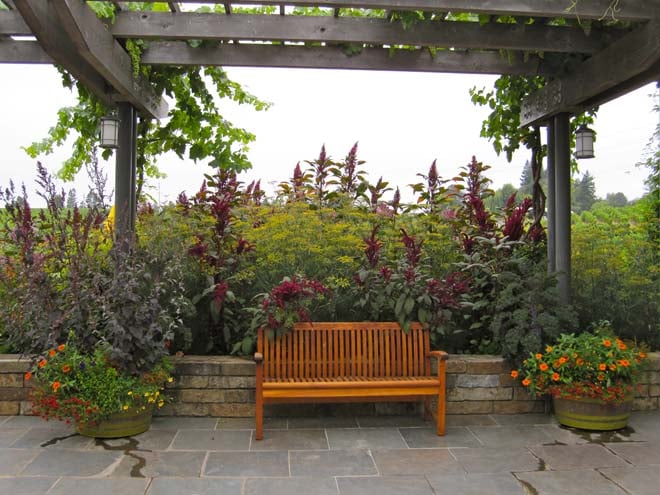
[sidebar]
Lynmar Estate Winery
3909 Frei Road, Sebastopol, California 95472
www.lynmarwinery.com
Daily tastings, $15 person
Knowledgeable staff offers complementary garden tours with tastings on Saturday; self-guided garden tours with tasting the rest of the week.[/sidebar]
Most edible gardens tend to be utilitarian spaces. Squads of segregated vegetables march down measured beds with no thought of beauty. Their final destiny—be it steamer or the Cuisinart—the only concern. Wildlife such as bees, beneficial insects, and birds are forgotten in the quest toward the dinner table.
We admire the rich and mingled colors of flower arrangements, carpets, and paintings, and our ornamental landscapes often reflect these tastes. In the same way, exquisite compositions of color and design from the leaves or seedheads of many vegetables can be combined to create edible paintings with vibrant—even fluorescent—hues, and finely etched or swirling baroque textures. Flowers contribute to the garden’s biodiversity and radiate life beside a cascade of edible color. The delineation between edible, ornamental, and life-filled dissolves, creating a tapestry of color, interest, and habitat value composed of easy-to-grow plants we can all enjoy.

Many wineries have edible gardens, although they are often kept out of sight so as not to distract from the “real” gardens that are designed to enhance and promote the wine-tasting experience. Lynn and Anisya Fritz, Lynmar Estate Winery owners, wanted to complement the enjoyment of wine by surrounding the tasting room with edible gardens to connect people with food as much as with wine. The winery is next to the Laguna de Santa Rosa, a wetland complex that is home to much wildlife, especially birds. Management practices in the vineyards and gardens are designed to support this diverse environment by including flowers that are colorful and that support pollinators, beneficial insects, butterflies, and many birds with the edible plantings. What better place to express these values than outside the main door?
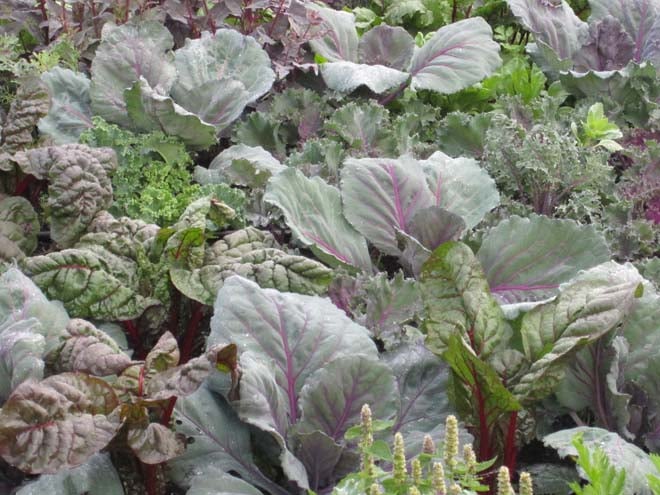
I began renovating the Lynmar gardens in November 2010 by combining many small beds into larger ones. Around the tasting room, the soil was extremely compacted and the workable depth extremely shallow. Without adequate and consistent soil fertility the gardens’ appearance was poor. Because the soil teems with gophers, beds were first lined with gopher wire. Then we boosted soil nutrients by increasing and upgrading the type and amount of mulch, organic compost, and fertilizer used in the gardens. Plants responded and leapt from the soil, eliciting pleased exclamations from guests as they stepped from the tasting room.
My idea was to create nibbling gardens; individual leaves or vegetables would be harvested here and there, leaving the ensemble intact for a prolonged harvest and viewing season. Flowers were chosen for ease of cultivation, bright colors, long bloom, and their ability to attract insects or birds, avoiding anything that needed deadheading or fussing with. To create workable gardens, almost everything in the spring through summer gardens needs to perform well and continually produce throughout the season, with the exception of lettuce and other greens—short-season crops are planted in succession along the edges of the beds. Crops are replaced in August and September with winter-hardy vegetables and flowers.

Warm Season Planning
In the greenhouse in February and March, seeds are started for red, gold, and magenta chard, and purple ‘Redbor’ kale—a brooding, frilly confection that has excellent heat tolerance—as well as leeks, celery, bulbing fennel, purple orach, ‘Bull’s Blood’ beet, ‘Red Russian’ and ‘Lacinato’ kale, purple cabbage, ornamental chiles, eggplant, ‘Sungold’ cherry tomato, and zucchini. For herbs and flowers we plant bronze fennel, anise hyssop, basil of every variety, and edible flowers like nasturtium, violas, and signet marigolds. To attract beneficial insects we start ageratum, sulphur cosmos and the white cosmos (Cosmos bipinnatus ‘Psyche White’), purple cleome, tithonia, ‘Sombrero’ zinnias, sunflowers, and plants with edible seeds like quinoa and amaranth. Seedlings are planted out as they are ready in April and May from six-pack size containers.
The flowers all have to bloom continuously without deadheading, be very colorful, and attract pollinators, beneficial insects, and birds like hummingbirds and finches. Cleome, cosmos, sunflowers, basils, and anise hyssop are favorite bee plants—both honeybee and native bees; tithonia and ageratum are favored by butterflies. Hummingbirds visit zinnias, cleome, anise hyssop, nasturtiums, and tithonia. Finches and nuthatches like the sunflowers and amaranth. Beneficial insects love the flowers of fennel, celery, and basil.
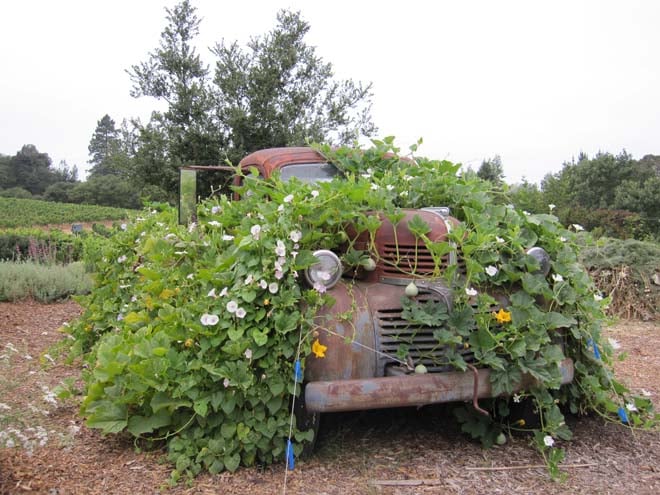
Vegetables were chosen for their beautiful foliage, fruits or seed heads, but also how they would combine into an impressionistic composition with no formal pattern but a desired collage of greens, blues, grays, lavender, purple, and red with various shades of shocking magenta, yellow, and crimson from chard as color accents. The flower colors were chosen to be complementary or to highlight the vegetables colors. Both vegetables and flowers are planted closely, just eight to ten inches apart in congregations of one, to create a dense, exuberant effect with no straight lines or plant groupings. As the summer progresses, the plants assume gigantic proportions as they leap skyward, and individual beds read collectively as a forest of flowers and edibles.
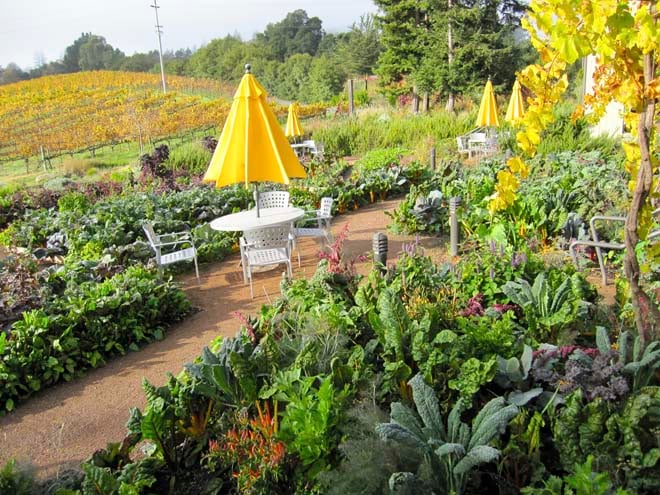
Cool Season Planning
When the summer array begins to look tired the beds are cleared and replanted with winter-hardy plants while the days and nights are still warm enough in August and early September to promote good growth.

The winter garden is much more subdued in tone and stature, reflecting the cool temperatures and thin light. Various shades of purple dominate, from ‘Redbor’ kale to the lighter shades ofpurple orach, the deepest red-purple of ‘Bull’s Blood’ beets, and the torn strands of ‘Ruby Frills’ mustard foliage highlighted by orange and rhubarb chard, and gray leeks. Bright green celery lightens the mood. With a lower profile than the summer garden, the individual personality of each vegetable stands out. ‘Lacinato’ kale has a perfect vase shape with leaves that curl like finials. ‘Ragged Jack’ or ‘Red Russian’ kale looks like lace-edged doilies, and purple cabbage leaves look like giant hand-painted petals. ‘Chidori’ kale has a heart of bright lavender among its frilly gray skirts. Radicchio is a study in paisley and red Pac choi could be a cubist representation of a woman. Contrasting wildflowers in brilliant shades of bright yellow, gold, deep blue and purple, like goldfields (Lasthenia glabrata), meadowfoam (Limnanthes douglasii), tidy tips (Layia platyglossa), and honeywort (Cerinthe major purpurascens), create a whole that is a feast for the eyes as well as the palate. Bees and beneficial insects are attracted to the honeywort and meadowfoam.
In all seasons, one plant is hardly distinguishable from the next and boundaries are erased; only abundant growth and an array of bees, insects, and hummingbirds—as well as astonished visitors—is the rule. It is enthusiastically exuberant even vivacious, perhaps close to intoxicating.

Though the scale at the winery is large, the concept of an energetic, edible, bio-diverse, and ornamental landscape can easily translate to the home garden, whatever the size. All the plants listed in this article are great candidates. Every year is another occasion to dream up lively new tapestries of flowers and food.
Share:
Social Media
Garden Futurist Podcast
Most Popular
Videos
Topics
Related Posts
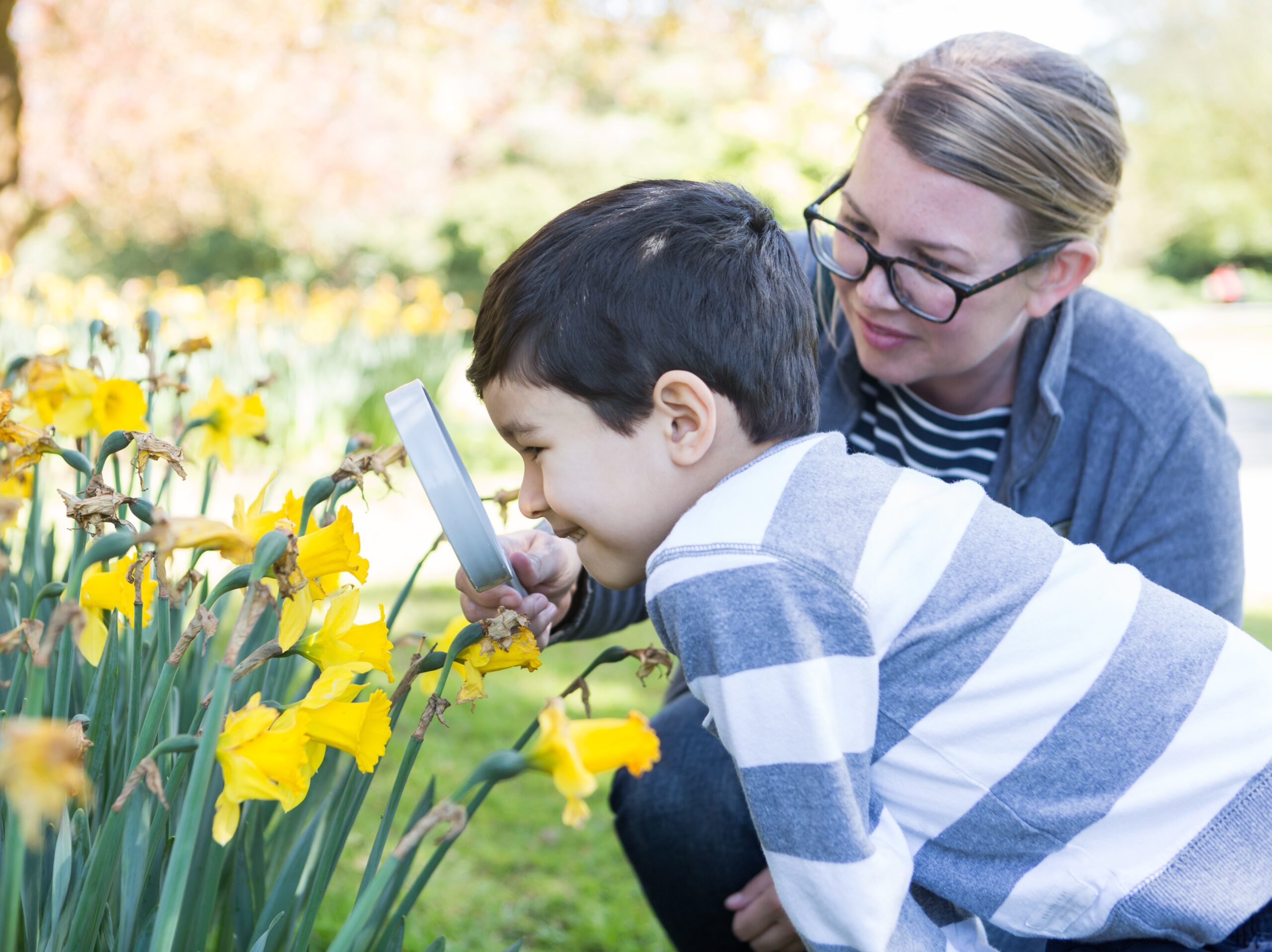
January Showers Bring February flowers…
Fall 2022 It may not quite have the same ring to it as the old English proverb, but it has a lot more truth to

Low Maintenance Gardens – Better for Pollinators and People
Autumn 2022 “I come out every day. It’s therapy, my meditation.” Janet’s young garden transformed from overgrown, invasive plants to mostly natives. The dailiness of

Calochortophilia: A Californian’s Love Affair with a Genus
Summer 2022 I can chart the progression of my life by Calochortus. For the last two decades, at least. As a teenage girl growing up

Pacific Plant People: Carol Bornstein
Spring 2022 Public gardens play a key role in demonstrating naturalistic planting design, selecting native and adapted plants for habitat, and testing techniques for reducing











Responses